The “Mecca of all good cyclists”: Ripley Road
The War of the Worlds, the pretty Dibble sisters, Occam’s Razor, women’s liberation, and the London Olympics: all are linked by the “most famous cycling highway in the world.”
 On Saturday, July 29th, 2012, a fast-moving peloton of professional cyclists swept through the Surrey village of Ripley. Braking before the High Street they banked to take a left-hand turn and then, seconds later, banked again to take a sharp right as the race headed down Rose Lane towards Dorking. None of the riders knew it but those 100 metres were part of a route that 19th Century cyclists described as the “best cycling highway in the world.”
On Saturday, July 29th, 2012, a fast-moving peloton of professional cyclists swept through the Surrey village of Ripley. Braking before the High Street they banked to take a left-hand turn and then, seconds later, banked again to take a sharp right as the race headed down Rose Lane towards Dorking. None of the riders knew it but those 100 metres were part of a route that 19th Century cyclists described as the “best cycling highway in the world.”
For 30 years, the Ripley Road was the go-to destination for the smart set of the day: young, athletic gentlemen at first; radical, bloomer-wearing ladies later. The ten miles between the Angel Inn at Thames Ditton and the Anchor hotel at Ripley were world-famous, and busy with cyclists on all manner of machines.
On Whit Sunday 1894, the police in Kingston upon Thames said 20,000 cyclists had passed through, en route to Ripley. An exaggeration, perhaps, but an indication also that Ripley was – according to tricycle-nut Lord Bury in 1887 – the “Mecca of all good cyclists.”
In the 1880s and 1890s, cycling was the marvel of the age, with bicycles and tricycles offering a revolutionary, individualised form of transport and leisure that captivated those who could afford what were expensive and technologically advanced pieces of equipment. Thanks to cyclists, long-neglected roads came to life again. Certain roads became famous, and none more so than the Ripley Road.
The Hub, an “Illustrated Weekly Journal for Wheelmen and Women” produced by the publisher of market-leading Tit-Bits tabloid in the ‘bicycle boom’ years of 1896 and 1897, described the road as “historic”:
Of all stretches of highway popular amongst cyclists, the Ripley Road, without dispute, is by far and away the most famous…The Ripley Road is known, at least by name, to cyclists in every part of the globe; and particularly in the case of American wheeling visitors…a ‘run to Ripley’ figures as surely on their programme, as does a trip to Stratford upon Avon.
The Ripley Road isn’t really the Ripley Road, it’s part of the old Portsmouth Road, from London to what was once England’s chief naval seaport. Twenty three miles distant from Westminster Bridge, Ripley was the perfect distance for a there-and-back day ride for metropolitan “cracks” on their fast and trendy high-wheeler bicycles.
The Portsmouth turnpike road – paid for by tolls raised by a turnpike trust incorporated by an Act of Parliament in 1749 – was capped with macadam, a stable surface of compacted small stones, known as metal, cemented together with rain water; stones crushed by the wheels of stage coaches to make a metalled road. Prior to the coming of the railways, twenty three coaches a day had raced along the macadamised London to Portsmouth Road. Many of the coaches carried sailors on leave. Ripley was a staging post and deliberately catered to the passing trade, with pub names such as the Anchor, the Ship and the Jolly Sailor. Ripley was the area’s post town from 1813 until 1865.
Portsmouth could be reached by rail by 1841, with Woking taking the place of Ripley as the area’s post town. Trains were faster, cheaper and more comfortable than stage coaches. Trains were the first Victorian transport marvel and ‘railway mania’ killed off the stagecoach trade, with formerly important towns, such as Ripley, bypassed.
In Lark Rise to Candleford, author Flora Thompson described how England’s rural roads, once heaving with traffic, had become hidden highways:
Three miles away trains roared over a viaduct, carrying those who would, had they lived a few years before or later, have used the turnpike. People were saying that far too much money was being spent on keeping such roads in repair, for their day was over; they were only needed now for people going from village to village…the children and their mother often walked their mile along the turnpike and back without seeing anything on wheels.
Bicycles changed this. Roads, including the Ripley Road, came to life once more. Coaching inns, in particular, welcomed the new trade, as described in a Daily Telegraph editorial of September 1880:
Not the worst thing that they have done, these knights of the road, has been to rehabilitate and set on their legs again many of our old posting-houses and decayed hostelries all over the country. Bicycles have…taken the place of coaches; they frequent all our great main roads, and gladded the hearts of innkeepers, who look out for the tinkling bells which herald the advent of a ‘club’ of wandering velocipedists, just as they anticipated of yore the gladsome tootling of the horn that bespoke the approach of the Enterprize, the Highflyer, or some other well-known conveyance of the old coaching days.
Highwheeler bicycles were difficult to ride, expensive to buy and, on a poorly surfaced road, dangerous. Potholes and large stones could see riders “come a cropper” and take a “header”. The turnpike roads of old had been engineered for speed (a stage coach could average 10mph on a metalled turnpike road) and were the roads of choice for the young, athletic riders of the new-fangled bicycles. Most riders were gentlemen, monied and with leisure time. A trickle of riders in 1869 became a steady trickle in 1870 and then a torrent by the late 1880s.
The Pickwick Bicycle Club, founded in 1870 and still extant today, has long organised an annual ride at Hampton Court Place, close to the ‘start’ of the Ripley Road ride. The third annual ride took place on May 26th 1877, and was immortalised in the drawing above which appeared in the Illustrated London News. Fixed front wheel velocipedes could be made to go quicker by enlarging the front wheel: the high wheel bicycle was the result and can be seen at the front of procession of up to 2,000 riders. Other London and some “provincial” clubs were also represented on the ride. There was a rider from Edinburgh and seven from Manchester.
The undulating Ripley Road was fast in parts, a good “scorching” road (the flattest, fastest stretch was at Fair Mile Common, near Cobham) but there were many other fine macadamised roads within easy reach of the centre of London. The Ripley Road was beloved by 19th Century cyclists for reasons other than just its speed. The road was scenic, dotted with clumps of “Surrey pines” on deserted commons. And the road was romantic: it passed Regency pleasure grounds and had been a famous haunt of highwaymen in pre-turnpike days. But, perhaps most important of all, the road was loved because of a pub: the Anchor inn in Ripley. This was a 16th century almshouse later converted into an inn. 30 years after the almost complete death of the coaching trade, hotels such as the Anchor were down on their luck. The Anchor, however, had a resourceful owner, Mrs Dibble, a widow. Two of her daughters worked in the inn, and they were, by all accounts, comely.
Annie and Harriet, their brother Alf, and Mrs Dibble, bent over backwards to please the new arrivals – cyclists were the first through traffic on rural roads since stage coaches – and the Anchor inn became the honeypot location on a honeypot road, most especially at weekends.
The Anchor, 23 miles from the dirty, industrious, smog-bound capital, was seen by cyclists as a beamed-ceiling throwback to simpler times. The early cyclists were the dominant users of the white Portsmouth turnpike road, and thought themselves in a rural idyll, a far cry from their life in a city of grime. (Thanks to soot, even London’s mud was black.)
Cycles were machines of escape; cycles offered independent means of locomotion out of overcrowded cities (London was an expanding metropolis of four million people in 1875) and, importantly, away from villages and towns being enlarged and “improved” by railways. A jaunt into the countryside appealed to upper and middle class Victorians who had a rosy, romantic view of agrarian ‘old England’, which was disappearing before their eyes. The rural aesthetic – inspired by thinkers and artists such as John Ruskin and William Morris – inspired many Victorians and they were keen to experience this “untouched” and “natural” countryside for themselves. The birth of the weekend – when middle class Victorians had time for play – saw an explosion in recreational activities, such as sight-seeing and taking part in sports. Not coincidentally, cycling combined both of these passions.
The Popular Recreator, an 1873 how-to book of sports and hobbies for the Victorian middle classes – it included sports such as cricket, fencing, polo, skating and swimming – said that recreation (for nobs only, presumably) was as necessary as work and education:
Toil rules the nation with iron hand whose finger points continuously in one direction, and says, “Work, that you may be wealthy.” Education stands, with a Minerva-like smile, calm and wise, and whispers, “Learn, that you may be wise.” To complete the trio, let us bring forward Recreation, bright of eye, glowing of cheek, with ruddy lip pouted to display her glistening teeth.
This “guide to out-door amusement” also had a section on cycling. Writer Charles E. Innes described a social ride he had undertaken in the summer of 1873, along the Portsmouth Road:
Before descending the hill leading from Ockham Common, let us rest a few minutes to enjoy the glorious sunset over Bolder Mere, with its dark background of firs, and the surrounding gorse lit up a sea of gold, for we may travel many a mile on our way ere we view a lovelier scene.
Bolder Mere is still there, albeit much reduced, and many of the commons that would have been familiar to Victorian cyclists are still there too, although it’s now necessary to tune-out the traffic noise from the six-lane A3 that today forms part of the “between the Houses” route from the Angel to the Anchor. The A3 is a motorway in all but name and the M25, London’s tarmac tourniquet, is another intrusion on to the landscape described by Innes.
Many other authors of the day waxed lyrical about the scenic wonders of the countryside along the Ripley Road, creating a romantic legend that attracted cyclists to the road for the best part of 30 years.
Part of this legend involved the history of the road. Nostalgia was key. In Coaching Days, Coaching Ways of 1888, W. Oustram Tristram wrote that the Portsmouth Road was the “Royal Road”:
…certainly kings and queens have passed up and down it, eaten and drunken in the Royal Rooms, still to be seen in some of the old inns; snored in the Royal Beds, and dreamed of ruts and bogs, and blasted heaths and impassable morasses, and all the sundry and other mild discomforts which our ancestors, whether kings or cobblers, had to put up with…
Tristram said the Talbot Inn at Ripley was “full of gables, long corridors, and hoary memories of gastronomic feats, performed by cramped travellers in the twinkling of an eye to the accompaniment of the guard’s horn, relentlessly proclaiming imminent departure.”
Back in the coaching days there had been a “constant throb of traffic on the direct Portsmouth Road,” said Tristram. In 1888 there was “not much throb of traffic about…now.”
Indeed, the villages and towns on the old Portsmouth road were now “suggestive of laudanum, mandragora, poppies, hop-pillows, and other sedatives.”
The commons and heaths that were later romanticised by the Victorians had been “rascally” in the 18th and early 19th Centuries; hideouts of footpads and highwaymen, such as the notorious Jerry Abershawe, the Laughing Highwayman, who plied his trade on the road between Guildford and his hometown of Kingston upon Thames.
In one of his Rural Rides (1830), pamphleteer William Cobbett wrote:
This county of Surrey presents to the eye of the traveller a greater contrast than any other county in England. It has some of the very best and some of the worst lands, not only in England, but in the world. We were here upon those of the latter description. For five miles on the road towards Guildford the land is a rascally common covered with poor heath…
 Yet the Portsmouth Road was also noted for running beside aristocratic pleasure grounds. These were not open to most of the passing cyclists – the National Trust wasn’t founded until 1895 – but they would have been familiar landmarks to middle class cyclists, and no doubt many unofficial visits were facilitated by the new means of locomotion. The pleasure grounds at Claremont country house, close to Esher and bordering the Portsmouth road, were an early example of an English Landscape Garden and had been worked upon by Sir John Vanbrugh and Lancelot ‘Capability’ Brown. In 1726 the gardens were described as “the noblest of any in Europe.”
Yet the Portsmouth Road was also noted for running beside aristocratic pleasure grounds. These were not open to most of the passing cyclists – the National Trust wasn’t founded until 1895 – but they would have been familiar landmarks to middle class cyclists, and no doubt many unofficial visits were facilitated by the new means of locomotion. The pleasure grounds at Claremont country house, close to Esher and bordering the Portsmouth road, were an early example of an English Landscape Garden and had been worked upon by Sir John Vanbrugh and Lancelot ‘Capability’ Brown. In 1726 the gardens were described as “the noblest of any in Europe.”
 The estate was once owned by Robert Clive, founder of Britain’s Indian Empire, and it later passed into royal hands. Queen Victoria was a frequent visitor to Claremont both as a child and later as an adult, when she bought the house and its grounds. In 1877 Queen Victoria presented nearby Esher with a drinking fountain and this would have been a favourite stopping point for cyclists doing a “run to Ripley.” [The fountain is still there, close to Esher’s very wide main street]. Sightings of Queen Victoria on the Ripley Road would have been relatively common. In July 1884, riders from the Holborn Cycling Club reported seeing Queen Victoria on the Ripley Road at Claremont. She was in an open landau drawn by two horses. The cyclists were on the way back to London after tea at the Anchor and, upon seeing the Queen, they drew up in a line and saluted her. She “gracefully bowed her acknowledgements.”
The estate was once owned by Robert Clive, founder of Britain’s Indian Empire, and it later passed into royal hands. Queen Victoria was a frequent visitor to Claremont both as a child and later as an adult, when she bought the house and its grounds. In 1877 Queen Victoria presented nearby Esher with a drinking fountain and this would have been a favourite stopping point for cyclists doing a “run to Ripley.” [The fountain is still there, close to Esher’s very wide main street]. Sightings of Queen Victoria on the Ripley Road would have been relatively common. In July 1884, riders from the Holborn Cycling Club reported seeing Queen Victoria on the Ripley Road at Claremont. She was in an open landau drawn by two horses. The cyclists were on the way back to London after tea at the Anchor and, upon seeing the Queen, they drew up in a line and saluted her. She “gracefully bowed her acknowledgements.”
Another estate that bordered the Portsmouth Road was Pains Hill, an estate visited by the likes of William Gilpin, the artist and author who popularised the “picturesque” landscape ethic; and John Adams and Thomas Jefferson, two of America’s founding fathers, the second and third presidents of the USA.
Pains Hill was created by the Honourable Charles Hamilton, an 18th-Century gentleman MP who transformed the “accursed hill” into an internationally-famous, naturally-landscaped pleasure ground, and one that was planned to have a “human pet”:
According to English Eccentrics and Eccentricities, an 1866 book by John Timbs, Hamilton was an “admirer of singularity and silence, and, having advertised for a hermit, he built a retreat for this ornamental but retiring person on a steep mound on his estate.”
The advertisement said the hermit must “continue on the hermitage seven years, where he shall be provided with a Bible, optical glasses, a mat for his feet, a hassock for his pillow, an hourglass for timepiece, water for his beverage, and food from the house. He must wear a camlet robe, and never, under any circumstances, must he cut his hair, beard, or nails, stray beyond the limits of Mr. Hamilton’s grounds, or exchange one word with the servant.
The first ornamental hermit lasted a full three weeks before being spotted at the local pub (the name of the hostelry is not noted) and was subsequently sacked.
There’s no hermit at Pains Hill today but the gardens have been restored to their former glory. Another garden of note, just to the north of Ripley, is the world-renowned Royal Horticultural Society’s Gardens at Wisley. This was a smaller, experimental garden in the 1890s – it was owned by a treasurer of the RHS – and would have been known to greenfingered cyclists, some of whom perhaps stopped for a tour before lunching at the Anchor.

The 30-year use of the Ripley Road was largely recreational but the first riders on the road had been racers. A party led by champion racer John Keen – a builder of high-wheel bicycles – is the first recorded use of the road by cyclists. Keen had started racing as early as 1869 and was, according to an article in Wheeling World in 1885, “in the first rank of cycling celebrities.”
Keen used the flat Fair Mile Common stretch of road in 1870 for a one mile challenge match against a rider from Kensington. The 1884 visitor book for the Anchor has an entry from Keen, saying he had been frequenting the pub since 1870. But he wasn’t attached to a single pub. In 1873 Keen and other riders met to discuss cycling matters in the Hut hotel, an alehouse overlooking Bolder Mere.
One of these matters was no doubt the state of the roads, including the once well-surfaced Portsmouth turnpike road. The stretch between Claremont Park and Guildford was “copiously stoned” wrote friends of Keen in 1877, a reference to a lack of maintenance of the Ripley Road.
Road maintenance was done – or, usually, not done – by parishes and local-ratepayers. Employed for the job were itinerant labourers. In the 1890s, some of the cyclists who rode on the Ripley road collected monies for ‘Road Menders’ feeds’, hot suppers for the old men who worked on the road between the Angel and the Anchor. The dinners were held from 1890 to 1908 with the road menders entertained, plied with tobacco and each given half a pound of tea.
Keen and his friends were interested in breaking records so needed the smoothest surface possible. They soon gravitated towards purpose-built cinder and wooden tracks. Recreational cyclists were more than happy with the surface of the Ripley Road. According to The Boy’s Own Paper, the 1870s roads out of London towards Portsmouth were “rough” but the Ripley Road wasn’t:
Starting from Westminster Bridge, along the Albert Embankment, through Wandsworth, over Wimbledon Common, to Kingston, the road is all macadam, and rather rough riding. From Kingston to Esher the road improves, and chance through Cobham to Ripley, twenty-three miles from London, is very good, but rather hilly.
Ripley is a delightful country place, six miles from a railway station, consequently free from excursionists. From Ripley to Guildford the road is splendid – six miles of the best roadway in England.
“Riding the Ripley road” was so popular that it came in for criticism in some quarters. In June 1885, Wheel World sniffed: “The Ripley Road craze is positively harmful to cyclists; men would be infinitely better in all respects for varying the direction of their journeyings.”
Clearly, this fell on deaf ears, as can be guessed at from this joshing from a Wheel World correspondent who wrote, in February 1885:
“Reader, bow the knee, and look reverently upon the great man who now claims the respectful adoration of the wheel world. He is — The Man Who Was The First To Sign The New Year’s Visitors’ Book At Ripley!
“Nor is the new dispensation confined to the first man who reaches Ripley on New Year’s Day. Such great deeds as these are so truly famous that a very large amount of the glare of celebrity attaches to the man who signs the 100th line in the same volume, and unto the man who signs the 1000th there will be awarded almost as much fame as the first signatory individual achieves. The plebeian mind may cavil at these great things, and wonder what greater credit attaches to the being who happens to put his name on a particular piece of paper at one particular moment any more than to any other individual who happens to attach his autograph to the same piece of paper at some other moment ; but the truly wise can afford to smile superciliously at the caviller, and leave him to grovel in his own lack of appreciation for mystic numbers.”
Ripley Road – and the Anchor inn – were key components in 19th Century cycling, in popular imagination, in the press and even in board games. Wheeling, the board game, went through a number editions from 1896 on, and featured, as the game’s destination, the Anchor hotel.
The Anchor inspired pedalling poets. E.S Ward of the Zephyr Bicycle Club of Maida Vale penned this ditty which he inscribed in the Anchor’s visitor book for July 3rd 1881.
Whenever I take my rides abroad
For this I’ll allus hanker,
That I’ll be guided by the Lord
to Ripley’s famous Anchor.
The Ripley Road also featured in novels. E. W. Hornung, author of the Raffles novels about a gentleman thief of the 1890s, placed his anti-hero on a bicycle in The Black Mask and had him ride upon the “incomparable Ripley Road.”
Two years before Arthur Conan Doyle (Hornung’s brother in law) wrote The Adventure of the Priory School, in which Sherlock Holmes demonstrated his ability to identify bicycle tyre treads – “I am familiar with forty-two different impressions left by tyres” – Hornung had Raffles doing the same:
“I had my eye on the road all the way from Ripley to Cobham, and there were more Dunlop marks than any other kind. Bless you, yes, they all leave their special tracks.”
Just as all roads once led to Rome, so most of the bicycle tracks on the Ripley Road – “the Appian Way of cycling,” wrote American author Elizabeth Pennell in Harper’s Magazine in 1897 – would have once led to the timber-framed Anchor inn. The metropolitan riders had to ride past other pubs to reach the smaller, cosier Anchor. The Talbot was run by elderly proprietors so tended to attract a more sober crowd; the Hut at Bolder Mere was scenic but quiet; the Hautboy at nearby Ockham (which is the Ockam referred to in Occam’s razor, the maxim that the simplest explanation is the most plausible, expounded by 14th Century theologian Father William d’Ockham) was popular for raucous musical parties, but it was the Anchor which attracted the majority of cyclists.
Henry Sturmey’s The Cyclist, first published in 1879, wrote of the Anchor’s charm which “brought more cyclists to its portals than any other [bicycling hostelry]”. Mine hosts, the Dibble family, were “as obliging a family to their customers as were ever collected together…” They had a “never-failing disposition to oblige with meals at all sorts of unearthly hours, and a wonderful patience to the noisiness of athletically-trained youths in general.”
This out-of-hours service was famous among local cyclists, one of whom wrote, in 1877:
“I pulled up at the Anchor…and asked what I could eat. Answered the fair Annie ‘Cold ham, cold mutton, cold beef.’ ‘Anything hot?’ asked I. ‘Mustard,’ said she, and scored one.”
Annie, then 22 (that’s probably her on the left in the engraving above, by C. J Staniland), was the prettier of the two Dibble sisters. In an 1880 article in The Wheel World, racer Harry J. Swindley wrote about bowing “at the throne of beauty”, thought to be a reference to Annie.
Swindley swooned over the ride to Ripley, too:
“The sweet door of the pine cones, whose resinous flavour imbues anew the jaded and half-choked city man, floats on a breath of the commons, scent-ladened by the flowering furze…At such moments the toiler realises that spots exist where the rush, the turmoil, the chicanery, deceit, and never-ending worry of city life is not.”
Annie was raved about by the riders (“…as comely as of yore”…”divine fair”…) but she never married, perhaps kept too busy catering to the hundreds of cyclists who descended on the hotel at the weekend.
Local historian Les Bowerman, a stalwart of the Veteran-Cycle Club and author of The Romance of the Ripley Road, has researched the Dibble family and has often wondered why Annie Dibble wasn’t married off to one of the many rich young gentlemen who sang her praises:
“They were a strange old lot, those Victorians, with their class distinctions. I guess it was a question of amateur gentlemen as opposed to ladies in trade. On one occasion, at Christmas, a bit of ‘squeezing’ was recorded, but that seems to have been as far as it went. Generally speaking, they seem to have kept to their allotted roles.”
That male cyclists were attracted to the Anchor’s because of the Dibble sisters was explicitly stated in a Wheel World article in June 1885, referring to a similar inn in Australia:
“Our [Australian] cousins can lay claim to having a Ripley of their own, although it is known to them by the name of Keilor. To this place, about ten miles out, the largest proportion of club runs are made, and, like our Surrey haunt, owes great part of its attraction to feminine charms. The landlady of the Keilor Hotel, who shows a worthy regard to the material wants of her guests, is possessed of no less than six daughters, each young and each pretty, and it needs very little acquaintance with cyclists to know that a ride is enjoyed none the less because at the end of it there are half-a-dozen young ladies, with other friends of the same sex, who are ready first to minister to the wants of their visitors, and then join them in the mazy waltz.”
Mrs Dibble died in 1887, Annie in 1895 and Harriet in 1896. A memorial window to the sisters was installed in the south aisle of the church opposite the Anchor, paid for by cyclists.
 Cyclists – many of whom attended services at the church; 126 attended on one Sunday in 1889, including many American visitors – also paid for the church’s Willis organ and erected a memorial to Herbert Liddell Cortis, the first cyclist to best 20 miles in one hour of pedalling. He completed the feat on a track not the Ripley Road but the church opposite the Anchor was the obvious place to erect a memorial to a cyclist.
Cyclists – many of whom attended services at the church; 126 attended on one Sunday in 1889, including many American visitors – also paid for the church’s Willis organ and erected a memorial to Herbert Liddell Cortis, the first cyclist to best 20 miles in one hour of pedalling. He completed the feat on a track not the Ripley Road but the church opposite the Anchor was the obvious place to erect a memorial to a cyclist.
Charles Harper, author of a nostalgic series of 1890s road history books, said the Ripley Road was the “most frequented by cyclists of any road in England…an almost inconceivable number take a journey down these twenty-three miles from London, and back again in the evening” but he disapproved of club cyclists, and women in ‘Rational dress’:
The Ripley Road…is the stalking-ground of self-advertising long-distance riders, of cliquey and boisterous club-men, and of the immodest women who wear breeches awheel.
Riding in a long skirt was difficult. The Rational Dress Society promoted knickerbocker suits, deemed too masculine by some. But Cycling reported in 1895 that “Rational dress is winning the battle between convention and comfort on the Surrey roads.”
In 1898, Viscountess Harberton, president of the Western Women’s Rational Dress Association, was refused luncheon in the coffee-room at the Hautboy & Fiddle in Ockham, close to the Ripley Road, because she had arrived on her bicycle wearing “exceedingly baggy knickerbockers reaching below the knee.” (The Hautboy, which once rang to the noisy musical parties so beloved of Victorian cyclists, is now being converted to luxury apartments). Lady Harberton left the hotel, no doubt in a huff, and lodged a complaint with the Cyclists’ Touring Club, which listed the Hautboy as one of the rider recommended hostelries of the area. The CTC took legal action against the landlady of the Hautboy and a trial took place in 1899. Mrs Martha Sprague, the landlady, was acquitted. The CTC lost this particular case – in law books it is known as Regina v Sprague – but the fight for women’s rights went on: woods close to the Ripley Road were later the destination for rides to support the suffragette movement.
Part of the fight for women’s rights was featured in The Wheels of Chance, a comic novel by author and noted cyclist H. G. Wells. His hero in the novel was Hoopdriver, an upwardly-mobile cycle tourist, who falls for Jessie, a young lady wearing ‘Rational dress’. The two ride together on, of course, the Ripley Road:
Mr. Hoopdriver …rode on in the direction of Ripley, along an excellent but undulating road. He was pleased to find his command over his machine already sensibly increased…”
Hoopdriver’s nemesis is a bounder called Bechamel, a rich gentleman rider, who rode a “machine of dazzling newness.”
At the sight of him Mr. Hoopdriver pulled himself together, and rode by with the air of one born to the wheel. “A splendid morning,” said Mr. Hoopdriver, “and a fine surface.”
“The morning and you and the surface be everlastingly damned!” said [Bechamel].
As Hoopdriver rode “swaggering along the Ripley road” he came to the Anchor inn (H. G. Wells renamed it the Unicorn for the novel) and “after propping his machine outside the door” he talked to the barmaid about the “weather, of the distance from London, and of the excellence of the Ripley Road.”
Ripley was later used by H. G. Wells is his more famous novel, The War of the Worlds, an epic about a Martian invasion of Earth:
It was this howling and firing of the guns at Ripley and St. George’s Hill that we had heard at Upper Halliford. The Ripley gunners…fired one wild, premature, ineffectual volley, and bolted…through the deserted village, while the Martian, without using his Heat-Ray, walked serenely over their guns, stepped gingerly among them, passed in front of them, and so came unexpectedly upon the guns in Painshill Park, which he destroyed.
Did H.G Wells, who often rode in the area, flatten Painshill Park because he hated the climb?
The War of the Worlds was first published in serial form in Pearson’s Magazine in 1897. This was the peak year for cycling in England, and for cycling on the Ripley Road (although not for visiting the Anchor; the peak years had been in the late 1880s; when the Dibble sisters died, trade died with it and Alf Dibble sold the Anchor to hoteliers from Guildford in 1897, although he returned in the 1920s, much to the delight of the local cycling clubs). The boom years of 1896 and 1897 were followed by a market crash and cycling slowly withered. This fading to grey wasn’t caused by the arrival of motorcars but motorcars certainly made Ripley Road – and all other roads in England – less inviting to cyclists.
By 1909, motor traffic was well on the way to strangulating Ripley, as described by Eric Parker in Highways and Byways in Surrey:
The Ripley road, for the two days in the week when it is most used, is a place to avoid. Yet it can be beautiful, and there is an approach to it hardly equalled near any other highway in the county…Ripley itself, but for the traffic, would be the prettiest village on the road…The motor-car has brought prosperity, even if it is a prosperity that can soil. But the tarnish washes off in night and rain. Ripley may look its best early on a Saturday morning, before the flood rushes down the road. When the little village lies clean and fresh in the sun…before the dust comes, there is a sense of orderly bustle and of waiting for a day of hard work and good money that is pleasant enough.
But the dust – thrown up by speeding cars – did come and it stayed in the air longer as more and more motorised vehicles used the road. Jessie Pope, a humourist and long-time contributor to Punch, found little humour in the coming of the motorcar. Her 1904 poem ‘Motor Martydom’ doesn’t hide her disgust:
I never have clung to a motor car,
Or crouched on a motor bike.
Worry and scurry, clank and jar
I cordially dislike.
I do not care for grimy hair,
For engines that explode,
But of one and all I’ve the put and call,
For I live on the Ripley Road.
I drank the country breeze at first,
Unsoiled by fetid fumes,
But now I am cursed with a constant thirst
That parches and consumes.
I am choked and hit with smoke and grit
When I venture from my abode;
My pets are maimed and my eyes inflamed,
For I live on the Ripley Road.
I pass my days in a yellow fog,
My nights in a dreadful dream,
Haunted by handlebar, clutch and cog,
And eyes that goggle and gleam.
I am not robust, but I dine on dust
Gratuitously bestowed,
And for twopence I’ll sell my house in the dell
By the side of the Ripley Road.
Motorists were not just guilty of creating dust clouds, they forced Ripley Road riders from their bicycles, as attested by this report from Bath Road News in March 1912:
Sal turned up to tea, cursing motors in general and with great particularity those which had driven him into the gutter.
Another cyclist wrote of seeing, near Wisley Hut, “a motor wreck – no uncommon sight on the Portsmouth Road these days.”
Use of the phrase Portsmouth Road here, and not Ripley Road, is instructive. By 1914, Ripley was no longer a terminus, a destination, but a dusty bottle-neck on what would be named, in the 1930s, the A3 between London and Portsmouth.
 By the end of the 1970s, the congestion was so bad a by-pass was built and Ripley became a back-water again. The Anchor now serves Thai food, not cold beef and mutton. Six miles of the “between the Houses” route – from the Angel to the Anchor – would be largely recognisable by the cyclists of the 1890s but the Hut at Bolder Mere was swept away in 1978 by builders of the A3. The bypass obliterates much of the route to Esher; cyclists are now sidelined with a narrow, poorly-maintained, sporadic cycle path.
By the end of the 1970s, the congestion was so bad a by-pass was built and Ripley became a back-water again. The Anchor now serves Thai food, not cold beef and mutton. Six miles of the “between the Houses” route – from the Angel to the Anchor – would be largely recognisable by the cyclists of the 1890s but the Hut at Bolder Mere was swept away in 1978 by builders of the A3. The bypass obliterates much of the route to Esher; cyclists are now sidelined with a narrow, poorly-maintained, sporadic cycle path.
This is a far cry from 1885 when an editorial in Cyclist in August 1885 said:
It is simply extraordinary how little the Ripley Road palls on one, even after 11 years’ traversing of it, for we never enjoyed a run more than one last week by moonlight to this cycling village…We met no less than 89 cycles in the first ten miles of the homeward journey, nine pedestrians, and only two vehicles.




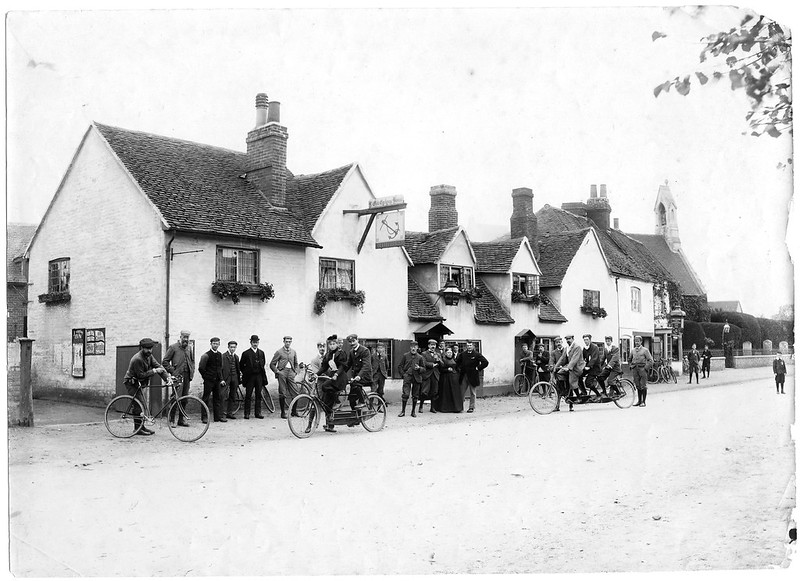
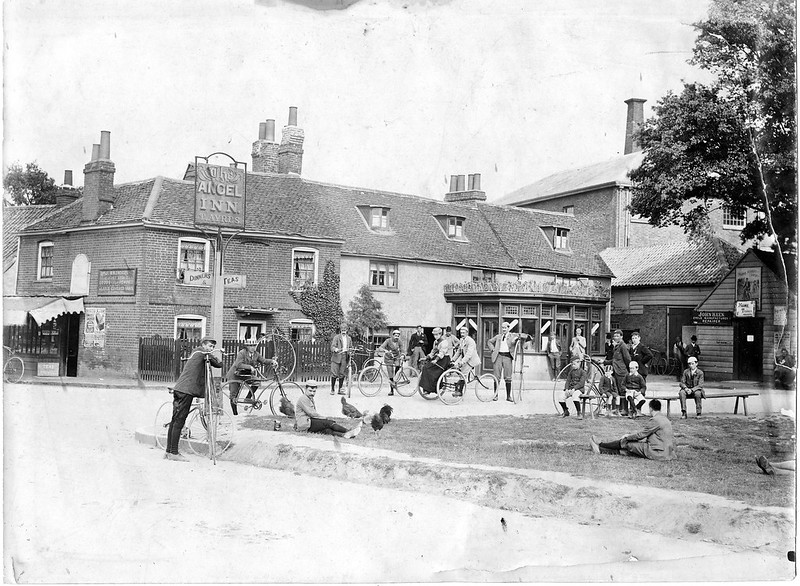
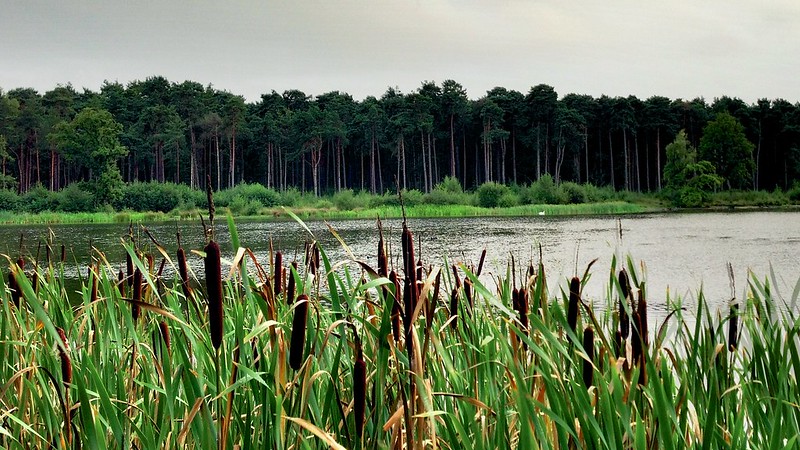
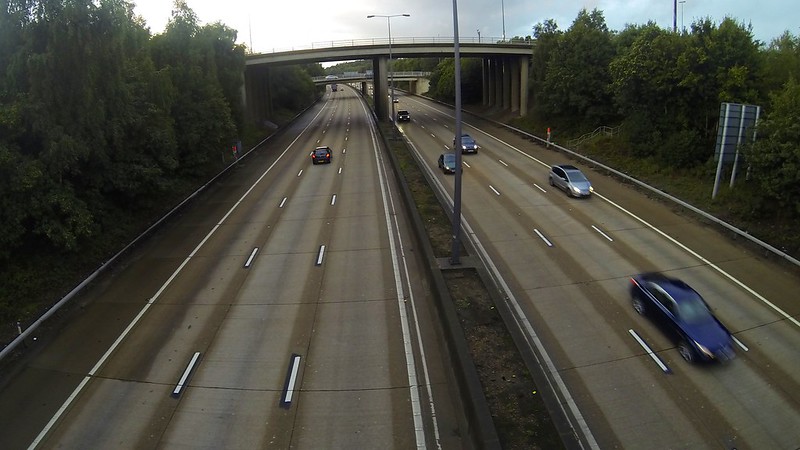
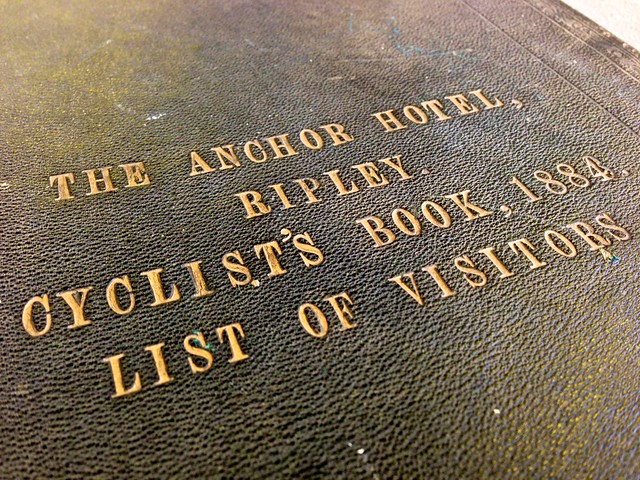
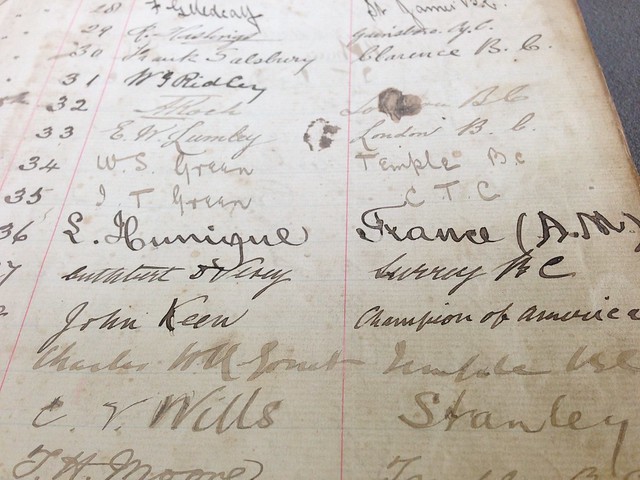




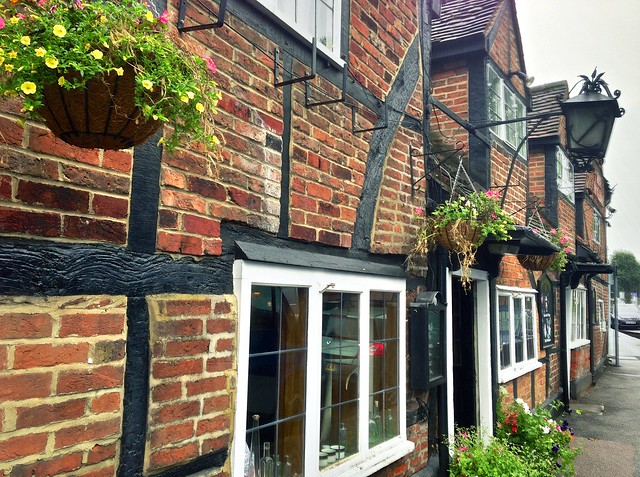
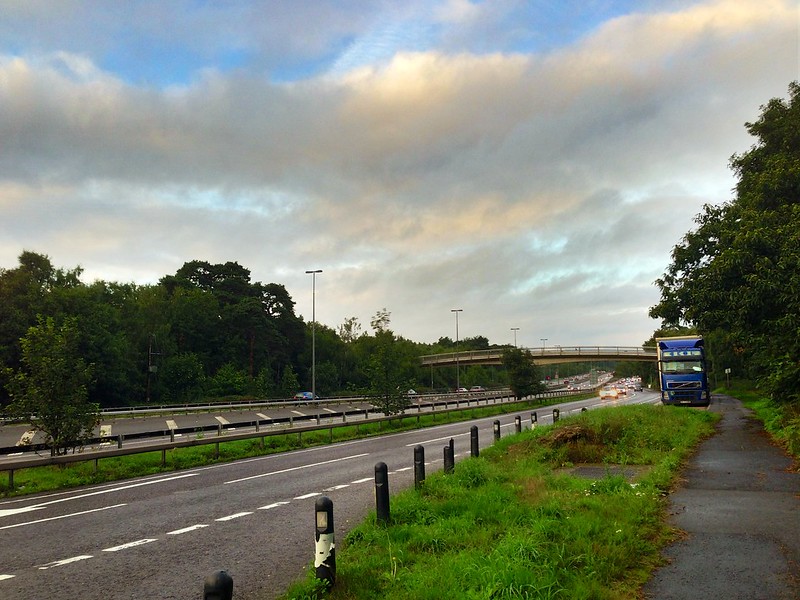
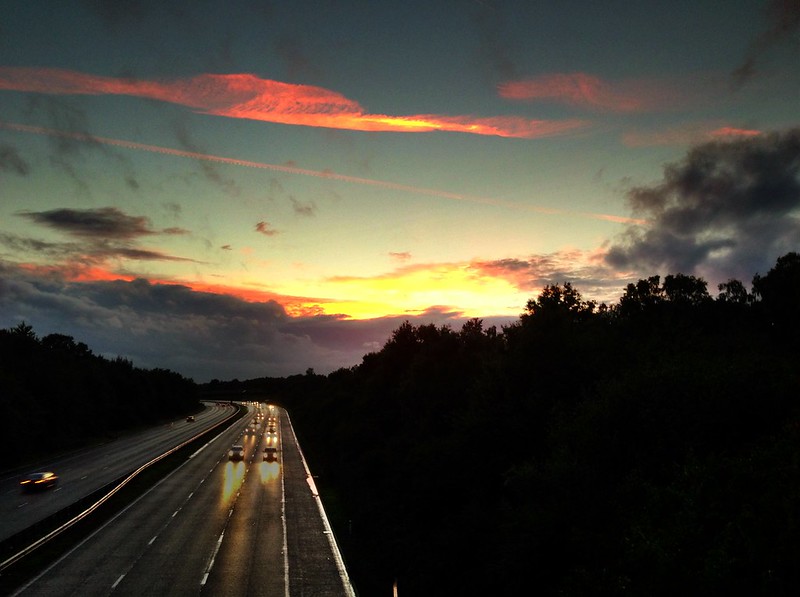
6 thoughts on “The “Mecca of all good cyclists”: Ripley Road”